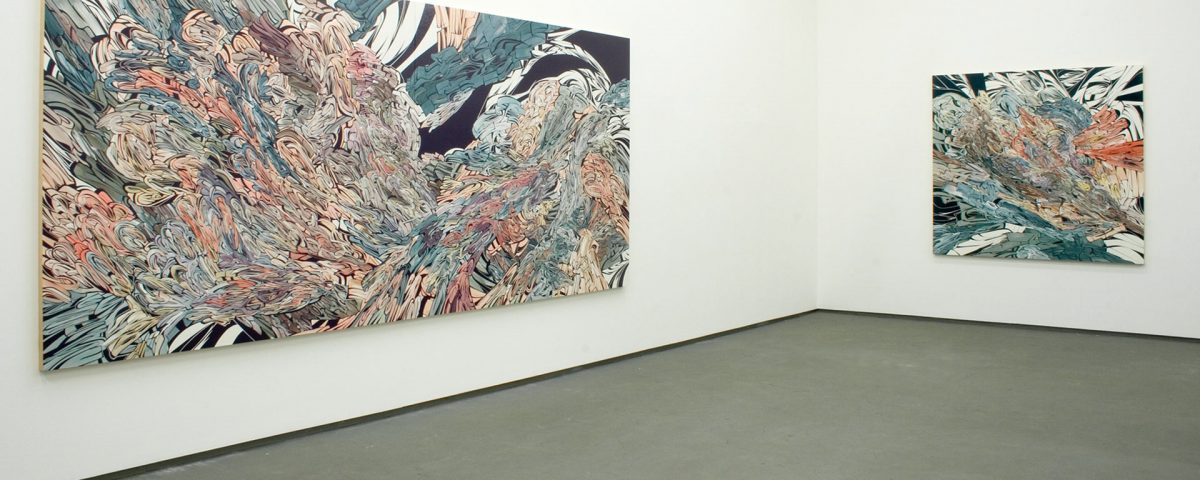
EMILIO PEREZ
10/10/–14/11/2008
Emilio Perez starts his paintings by coating primed wooden panels with dark enamel, in deep purple, murky slate, or blackish sea green, although never actually in black itself. He covers this completely in thick layers of white latex, and, on top, paints acrylic in various colors admixed with plenty of white to give the chalky or pastel hues he favors — fleshy peach, dirty baby blue, diminished vermilion, chewed mint. He brushes these on loosely, with broad, sweeping strokes. Then, diverging from traditional painting practice, the artist takes up an X-Acto knife instead of another brush. He cuts into the upper layers of the panels, through the acrylic and latex, lifting and peeling them from the enamel below, and exposing the underpainting. The cuts follow a pattern roughly determined by the final layer of colored strokes, but equally governed by habitual movements of his hand and arm, and an approximate sense of a desired result.
With this unique method of working, Perez renders hordes of intertwining forms that seem to surge across his panels through indeterminate spaces suggested by open areas of the revealed dark enamel, themselves structured by swooshing arcs in bright white, where no color was applied. The cutting and delaminating also produce the sharp, dark outlines that define the writhing forms — themselves tinted with his odd, pale, impure hues — and read as nearly black, imparting a strongly graphic quality to the compositions, as if they comprised diagrams of biomorphic Surrealism. They also recall Roy Lichtenstein’s comic-strip versions of Abstract Expressionist brush strokes, but rather than parodies of spontaneous gesture, Perez’s exhilarating images, in fact, arise from it.
Unlike Lucio Fontana, another painter of note to have wielded a blade, Perez seeks not to pierce the surface to the metaphysical depths beyond, but to incise the skin of painting to articulate form and space. We can liken his process to drawing, particularly as his cuttings individuate component areas, delineating contour, and implying volume and torsion. More specifically, his technique corresponds to automatic drawing, beloved by the Surrealists for allowing the expression of the subconscious. Using only a vague framework, Perez slices into the paint with minimal preconception of the final form his image will take. Yet, despite this unpremeditated approach, the finished panels cohere as a consistent body of work, evincing a style and a formal repertoire developed over long years of an intensive drawing practice, as well as from experimental methods that have ranged from wood-burning to Shrinky Dinks.
Perez’s hand moves in a particular and personal way over any surface, and engenders an idiosyncratic taxonomy of abstract figures that conjure a plethora of associations. The forms in the largest of his new works, dreaming out of season, for instance, evoke compressed loops of ribbon, draperies in motion, viscera, mineral deposits, and bits of squashed cartoon characters—Perez seems to return to a configuration resembling Donald Duck’s bill over and over again — sometimes all at once. These torrents of forms roil across the two squarish panels like magma in an underground cavern of midnight violet. A formation curls up in the center foreground as a dragon-headed solar flare, and behind it, the composition resolves into several concavities. Too cool to cry features a similar array of forms that appear to explode from a central vanishing point within a parabolic space supported by gray beams that somehow evoke Haida canoe paddles. At the same time, both figure and ground intimate division into horizontal registers that seem to move in different directions, as if space itself were fragmented and shifting. An elastic, pinkish knot of compacted, irregular swirls in snap your fingers merges with a craggy, scaly background to which it also seems tethered at multiple points.
It is undoubtedly no accident that descriptions of Perez’s paintings almost necessarily invoke science-fiction scenarios, for its imagery, both visual and literary, provides some of the clearest affinities to his own. His abstract forms appear simultaneously organic and inorganic, alive and not, internal and external, animal, vegetable, and mineral all at once. They creep and swarm like sentient kudzu or an unnamable, invasive, continuously multiplying and transforming entity with clear intention but unknown purpose. This is The Blob writ as high modernism. Perez’s conception of space — enigmatic, fractured, not quite rational, possibly animate — likewise partakes of a trippy sci-fi vibe, but also of the “non-Euclidean” space of the Surrealists, especially Matta. In fact, Perez liberally conflates references to both high and pop culture in his paintings; non-representational though they are, they nonetheless visually echo genres as disparate as Art Nouveau, Japanese anime, Mike Kelley’s renditions of George Baker’s Sad Sack, Kurt Seligman, Celtic ornament, woodblock prints, “wild style” graffiti lettering, and Walt Disney.
Perez does not deliberately design these varied allusions. His forms never coalesce into recognizable iconography, staying stubbornly equivocal, polymorphous, representing nothing other than themselves; his methods always remain improvisatory, automatist, inventing images rather than depicting them. He seems to have absorbed a wealth of visual information almost by osmosis, and it reappears, as elusive suggestions within the matrix of his painted and peeled surfaces, just as reflexively. He models his process, and his product, on those of artists at mid-century, but his panels have no truck with art-historical reenactment. Cutting into the skin of abstract painting, Perez grafts on the optical unconscious of the present.
Joseph R. Wolin
